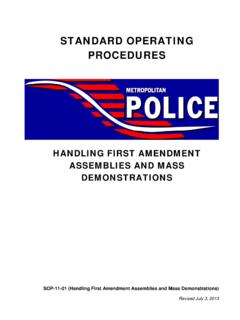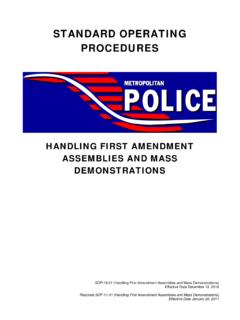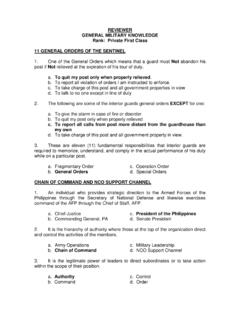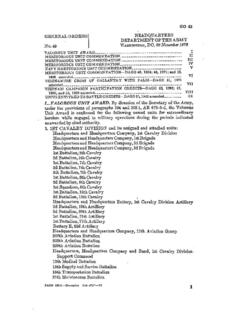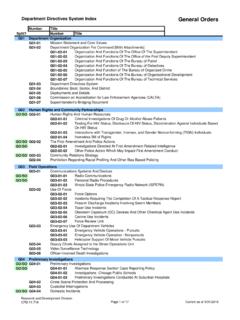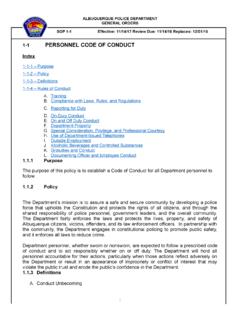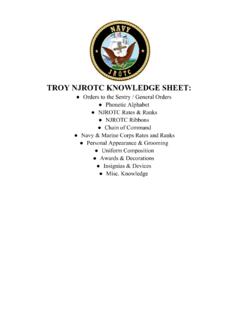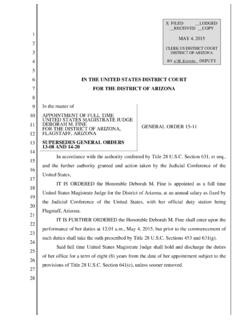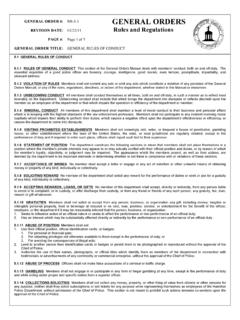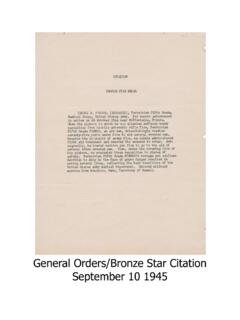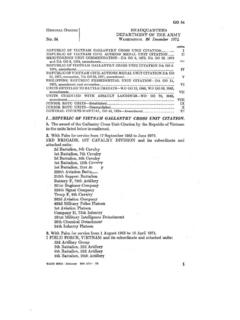Transcription of GENERAL ORDER - mpdconline.com
1 GENERAL ORDER DISTRICT OF COLUMBIA I. BACKGROUND Regulations pertaining to the use of force by law enforcement officers are outlined in chapter six of the District of Columbia Code of Municipal Regulations (DCMR), the Fourth Amendment of the United States ( ) Constitution, and various other sections in the Official Code of the District of Colombia ( Official Code). The DCMR provides guidance regarding a law enforcement officer s use of force including, but not limited to, outlining the circumstances permitting appropriate levels of force and imposing restrictions on firearm discharges. The Fourth Amendment of Title Use of Force Topic Series Number RAR 901 07 Effective Date November 3, 2017 Replaces: GO-RAR (Use of Force), Effective Date December 1, 2016 Related to: (Vehicular Pursuits) (Canine Teams) (Handling of Service Weapons) [Oleoresin Capsicum (OC) Spray Dispensers] (Use of Force Investigations) (Use of Force Review Board) (Force-Related Duty Status Determination) I.
2 Background Page 2 II. Policy Page 2 III. Definitions Page 2 IV. Regulations Page 5 De-Escalation Page 5 Justification Page 5 Response Page 5 Excessive Force Page 5 Use of Force Framework Page 5 Conditions that May Authorize the Use of Non-Deadly Force Page 8 Conditions that May Authorize the Use of Deadly Force Page 9 Less Lethal Weapons Page 10 Positional Asphyxia Precautions Page 10 Neck Restraints Page 10 Use of the Department-Issued Firearm Page 11 Carrying Prohibited Weapons Page 12 Pain or Injury Associated with Handcuffing Page 12 Handcuff Prohibition Page 13 Civilian Employees of the Department Page 14 Reporting Use of Force Incidents Page 14 V. Attachments Page 14 VI. Cross References Page 14 USE OF FORCE ( ) 2 of 15 the Constitution guarantees people the right to be secure in their persons and provides a framework in which the courts can evaluate the use of force by law enforcement officers, including the objective reasonableness standard established in Graham v.
3 Connor 490 386 (1989). The purpose of this ORDER is to outline when members may use force. II. POLICY The policy of the Metropolitan Police Department (MPD) is to value and preserve the sanctity of human life at all times, especially when lawfully exercising the use of force. Therefore, MPD members shall use the minimum amount of force that the objectively reasonable officer would use in light of the circumstances to effectively bring an incident or person under control, while protecting the lives of the member or others. When using force, members shall continuously reassess the perceived threat in ORDER to select the reasonable use of force response, or one that is proportional to the threat faced by him, her, or others. III. DEFINITIONS When used in this directive, the following terms shall have the meanings designated: 1.
4 Active resistance physically evasive movements to defeat or deflect the member s attempts to control a subject, including but not limited to, bracing, tensing, pushing, or verbally signaling an intention not to be taken into or retained in custody, provided that the intent to resist has been clearly manifested. 2. Carotid artery hold ("sleeper hold" or "v hold") any technique which is applied in an effort to control or disable a person by applying pressure or force to the carotid artery or the jugular vein or the sides of the neck with the intent or purpose of controlling a person's movement or rendering a person unconscious by constricting the flow of blood to and from the brain ( Official Code, 5-125). 3. Less lethal weapon any object or device deployed with the intent or purpose of nullifying a threat without causing death ( , rubber bullets, oleoresin capsicum spray, and tactical batons).
5 4. Member sworn or civilian employee of MPD or MPD Reserve Corps member. 5. Non-deadly force any use of force that, when employed in accordance with Department training, is neither likely nor intended to cause death or serious physical injury. 6. Objective reasonableness the standard requiring the reasonableness of a particular use of force must be judged from the perspective of a reasonable member on the scene in light of the facts and circumstances confronting the member. USE OF FORCE ( ) 3 of 15 7. Resisted handcuffing occurs when a person actively resists being placed in handcuffs, and the member must forcibly move the person s wrists or arms, or physically maneuver the person s body so that the handcuffs can be applied. The resistance may range from an active struggle to a person simply locking his or he arms to prevent their being moved to the handcuff position.
6 8. Serious physical injury any injury or illness that results in admission to the hospital or that creates a substantial risk of death, serious disfigurement, loss of consciousness, disability, a broken bone, or protracted loss or impairment of the functioning of any body part or organ. NOTE: Admission to the hospital must be directly associated with the use of force, and should not include treatment or hospitalization for those injuries incurred prior to the use of force ( , drug or alcohol use, medical conditions such as high blood pressure). 9. Serious use of force actions by members including: a. All firearm discharges by a member with the exception of range and training incidents, and discharges at animals; b. All uses of force by a member resulting in a serious physical injury; c.
7 All head strikes with an impact weapon; d. All uses of force by a member resulting in a loss of consciousness, or that create a substantial risk of death, serious disfigurement, disability or impairment of the functioning of any body part or organ; e. All incidents where a person receives a bite from an MPD canine; f. All uses of force by an MPD member involving the use of neck restraints or techniques intended to restrict a subject s ability to breathe; and g. All other uses of force by a member resulting in a death. 10. Service weapon any instrument issued or authorized by the Department that is used to control or overcome a subject, carried or kept readily available by MPD members. 11. Take down maneuver in which a subject is forcibly brought to the ground.
8 USE OF FORCE ( ) 4 of 15 12. Trachea hold ("arm bar hold" or "bar-arm hold") any technique using the member s arm, a long or short police baton, or a flashlight or other firm object that attempts to control or disable a person by applying force or pressure against the trachea, windpipe, or the frontal area of the neck with the purpose or intent of controlling a person's movement or rendering a person unconscious by blocking the passage of air through the windpipe. ( Official Code, ) 13. Use of force any physical coercion used to effect, influence or persuade an individual to comply with an ORDER from an officer. a. The following actions are designated reportable uses of force : (1) Deadly force; (2) Serious use of force; (3) Use of a less-than-lethal weapon; (4) Any use of force indicating potential criminal conduct by a member; and (5) Any use of force resulting in injury or a complaint of injury or pain where the injury or pain is directly associated with a member s use of force.
9 B. The following actions are designated reportable force incidents as long as the use of force does not result in injury or a complaint of injury or pain: (1) All solo or team takedowns, where there is no complaint of pain or injury; and (2) The drawing and pointing of a firearm at, or in the direction of, another person when no other force was used. NOTE: Minor injury or discomfort resulting from the application and GENERAL wearing of handcuffs is not, in and of itself, considered a reportable use of force or a reportable force incident . 14. Use of force framework an adaptation of the decision making model (Attachment A) specifically applicable to situations potentially resulting in the use of force. The use of force framework contains five categories of perceived threats and responses, all of which are fluid, dynamic, and non-sequential.
10 The use of force framework allows officers to USE OF FORCE ( ) 5 of 15 determine which action or actions are objectively reasonable and proportional, given the perceived threat. 15. Use of force indicating potential criminal conduct by a member includes, but is not limited to, all strikes, blows, kicks or other similar uses of force against a handcuffed subject and all accusations or complaints of excessive force made against the member. This includes any use of force that clearly goes beyond that which an objectively reasonable officer would use in light of the circumstances under which the force was used, or any use of force which may rise to the level of a criminal act. 16. Vehicle ramming attack form of attack in which a perpetrator deliberately rams, or attempts to ram, a motor vehicle at a crowd of people with the intent to inflict fatal injuries.
